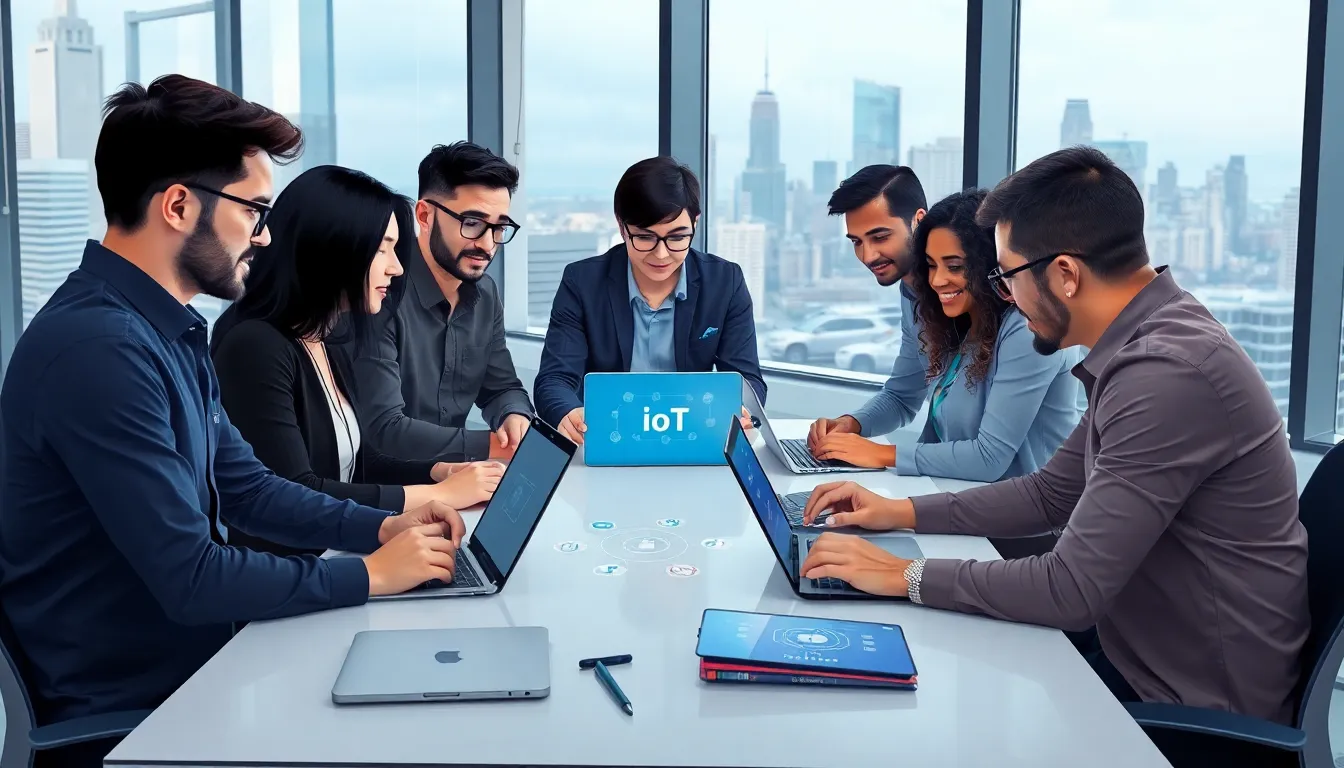In a world where your toaster might just be smarter than you, the Internet of Things (IoT) has transformed everyday objects into tech-savvy companions. Imagine a universe where your fridge can text you when you’re low on milk, or your thermostat knows just how cozy you like it. This isn’t science fiction; it’s the reality of IoT software development, and it’s changing the game for businesses and consumers alike.
Table of Contents
ToggleOverview of Internet of Things Software Development
Internet of Things software development involves creating applications that enable communication between smart devices and the internet. Developers optimize software to ensure seamless interaction among various IoT devices, enhancing user experiences.
Platforms such as cloud computing provide essential infrastructure for IoT applications. These platforms allow devices to store and process data efficiently. Utilizing real-time analytics plays a vital role in making informed decisions based on collected data.
Security measures are critical in IoT software development. IoT devices often handle sensitive information, making it essential to implement robust security protocols. Encrypting data and ensuring secure communication channels protect user privacy and system integrity.
Diverse programming languages are commonly used in IoT development. Languages like Python, Java, and C++ facilitate the creation of effective applications tailored to different devices. Each language offers unique advantages, addressing specific development needs.
Integration with existing systems remains a significant consideration. Developers must ensure IoT applications can communicate with legacy systems, enhancing functionality. APIs serve as bridges, allowing different systems to work together effortlessly.
Testing and validation are crucial steps in the development process. Rigorous testing ensures that IoT applications function correctly and meet performance standards. Adopting agile methodologies enables developers to iterate quickly, addressing issues promptly.
Industry standards shape the landscape of IoT software development. Compliance with these standards promotes interoperability among devices, allowing a diverse ecosystem to thrive. Organizations that align with established standards gain trust from users and stakeholders.
Key Technologies in IoT Software Development


Key technologies drive the advancement of IoT software development, enabling smarter ecosystems and enhanced user experiences. Three critical areas include cloud computing, edge computing, and machine learning.
Cloud Computing
Cloud computing serves as the backbone for IoT applications. It provides scalable infrastructure for data storage and processing. Users benefit from accessing vast amounts of data seamlessly, enabling real-time analytics. Notably, platforms like AWS and Microsoft Azure offer services specifically tailored for IoT solutions. These platforms support device communication, data security, and integration with existing applications. Additionally, flexibility in resource allocation allows developers to optimize performance based on demand.
Edge Computing
Edge computing reduces the latency inherent in traditional cloud models. It processes data closer to where it is generated, thus minimizing response times. Devices equipped with edge computing capabilities enhance real-time decision-making, a crucial element for applications like autonomous vehicles. By offloading work from cloud data centers, bandwidth consumption decreases significantly. Many IoT devices can operate independently, increasing reliability and performance in scenarios where connectivity may be limited.
Machine Learning
Machine learning plays a transformative role in IoT development. Algorithms analyze vast datasets to identify patterns and enable predictive analytics. This technology allows devices to learn from user behavior, adapting their functions to better meet individual needs. Applications span various sectors, from smart home systems that optimize energy consumption to industrial IoT solutions that predict equipment failures. Furthermore, continual improvements in machine learning models foster advancements in automation and operational efficiency.
Development Process for IoT Applications
The development process for IoT applications involves several key steps to ensure functionality and reliability. Each stage requires careful planning and execution.
Requirements Gathering
Requirements gathering is critical for defining the application’s purpose. Stakeholders articulate their needs, guiding the development team in outlining features and specifications. Engaging with end-users helps identify pain points and expectations, which is vital for creating user-centered applications. Documenting these requirements ensures clarity and alignment among team members. This collaborative effort fosters a strong foundation for the project, facilitating a shared understanding of goals.
Prototyping and Testing
Prototyping allows the team to create a functional model of the IoT application. Developers utilize tools like wireframing software to visualize the user interface and features. Testing comes next, ensuring the prototype meets design expectations and performs effectively under various conditions. Feedback from stakeholders during this phase is invaluable, allowing for iterative improvements. Rigorous validation through various testing methods, such as unit tests and integration tests, confirms that the application operates correctly and meets security standards.
Deployment and Maintenance
Deployment involves launching the IoT application to users. A strategy for seamless integration with existing systems is essential during this phase. After deployment, ongoing maintenance becomes necessary to address potential issues and implement updates. Regular monitoring ensures optimal performance, while user feedback informs future enhancements. Adhering to industry standards facilitates compatibility with other devices and systems, further improving user trust and satisfaction. Responsive support and continuous development play crucial roles in maintaining the application’s relevance and efficiency.
Challenges in IoT Software Development
IoT software development presents several challenges that developers face during the creation process.
Security Concerns
Security concerns rank as one of the top challenges in IoT software development. Vulnerable devices can become targets for cyber-attacks, exposing sensitive user data. To counteract these risks, developers prioritize implementing strong encryption protocols and regular updates. That approach improves device security and fosters user trust. Adhering to best practices for authentication and authorization also proves crucial in safeguarding networks against unauthorized access. Integrating security measures from the outset reduces potential threats throughout the lifecycle of IoT systems.
Scalability Issues
Scalability issues frequently arise as IoT applications grow in complexity and user base. Systems must handle increased data volumes and support additional devices seamlessly. A lack of infrastructure can lead to degraded performance, impacting user experience. Effective design should account for future growth by utilizing scalable cloud solutions. Such platforms offer adaptable resources, enabling smooth scaling to accommodate evolving demands. Developers need to establish a flexible architecture that can adapt to fluctuations without compromising efficiency.
Interoperability Problems
Interoperability problems hinder effective communication among diverse IoT devices. Various manufacturers often adopt different protocols and standards, leading to fragmented ecosystems. Ensuring that applications work harmoniously across platforms is essential for success. Developers must employ standardized APIs to facilitate communication between devices and systems. Implementing industry standards enhances compatibility and encourages wider adoption. Fostering collaboration among industry players can further bridge these gaps, promoting a cohesive IoT environment.
Future Trends in IoT Software Development
In the rapidly evolving landscape of IoT software development, several key trends are emerging. Increased focus on security remains paramount as developers prioritize robust encryption and authentication methods. Enhanced data analytics capabilities allow businesses to gain deeper insights from device-generated data, enabling better decision-making.
Adoption of artificial intelligence is transforming IoT applications. AI algorithms enhance device intelligence, leading to more predictive capabilities and user-centric interfaces. Edge computing continues to gain traction due to its ability to process data closer to the source, reducing latency and improving overall performance.
Integration of 5G technology is a game changer for IoT. With faster data transfer rates and lower latency, 5G supports the increasing connectivity demands of smart devices. Scalability concerns are addressed through the development of more flexible architectures, allowing applications to grow alongside user needs.
Moreover, open-source solutions are gaining popularity in IoT development. They provide the advantage of customization and foster collaborative innovation, enabling developers to build more efficient applications. Industry collaboration becomes critical as companies work together to establish standardized protocols for interoperability.
Sustainability efforts are also influencing IoT trends. Developers are focusing on energy-efficient designs that minimize environmental impacts while enhancing device longevity. As the role of IoT expands across sectors, compliance with regulations and standards will ensure that devices work seamlessly together, building user trust and confidence.
Overall, the future of IoT software development promises exciting advancements that facilitate smarter, more secure, and environmentally friendly devices. Each trend shapes the potential of IoT applications, enhancing user experiences and expanding market opportunities.




